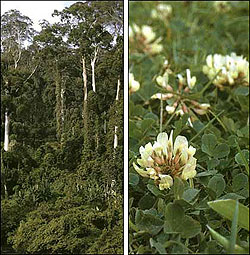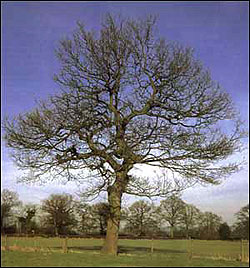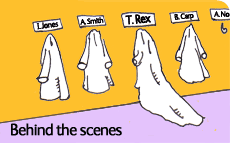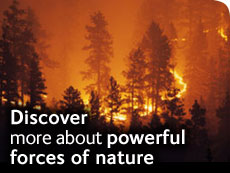Trees: Magnificent structures
Roland Ennos
The advantages of being a tree

Surprisingly the emergent tree on the left, Koompassia excelsior (with the pale trunk), from the rainforests of Borneo, is not closely related to its superficially similar neighbours. A closer relative of Koompassia is the tiny white clover Trifolium repens, on the right, which is only a few centimetres tall. (Left: Roland Ennos)
There is no doubt that trees are extremely successful. More than 80,000 species, ranging from tiny arctic willows a few centimetres high to giant redwoods that can grow to over 100 metres tall, cover 30 percent of dry land. It is difficult to assess the reasons for this success because trees do not form a natural biological group. Whereas other successful groups of plants, such as grasses, all descend from a single common ancestor, the tree form has evolved many times in the course of history; trees' ancestors were quite unrelated plants. As a result, unlike grasses, trees support a huge variety of reproductive structures; oaks produce acorns while pines produce cones. Although a tree superficially looks like its tree neighbours, it may in fact be more closely related to a small herb or shrub.
It is clear, therefore, that the success of trees is not due to their reproductive characteristics; it must instead be due to their basic body plan. The accepted definition of a tree is that it is a plant with a more-or-less permanent shoot system that is supported by a single woody trunk. At first sight this might not seem to be a good design because only a small fraction of a tree's biomass--its leaves--is capable of photosynthesis. Therefore much of the energy produced by the leaves has to be diverted to make unproductive tissue (such as the woody trunk, branches and roots) as the tree grows. In comparison, a plant composed almost entirely of a flat plate of photosynthetic cells (like a duckweed) has the capability of growing and reproducing much faster. It must be remembered, however, that plants do not grow on their own but must compete with other plants for water, nutrients, and especially light.

An oak tree Quercus robur in winter, showing the characteristic structure of a typical tree: a single trunk supporting a branching crown. (Image: Roland Ennos)
Trees are excellent competitors for light; they are able to hold their leaves above those of other plants and shade them out. They have a permanent structure above the ground and each year their shoots have a head start over those of non-woody herbaceous plants. Tree shoots grow from buds high up on the tree, whereas the herbaceous shoots, which die back each year, have to grow up from the ground. Shrubs also have a permanent woody structure, so how do trees out-compete shrubs for light? The answer lies in the differences in their structure. Shrubs typically branch near the ground and so have several narrow stems rather than a single trunk. These stems can support lots of leaves, but weight for weight they are less rigid than a single thick trunk. For this reason shrubs do not typically grow as tall as trees; the stems bow down under their own weight, whereas the single rigid trunk of a tree is easily able to support itself. The best strategy for a tall plant is to grow with a single trunk that branches near the top. Even so, this structural design has a downside: the woody trunk and branches are energetically expensive to construct. This makes trees relatively slow-growing compared with herbaceous plants. However, trees are able to live a long time because wood is a strong, long-lasting material; it is also cheap to maintain because most of the cells are dead.
Ready reference
Biomass The total dry weight of organisms in a particular population or area.
Herbaceous plant (herb) A non-woody plant with a relatively short-lived shoot system.
Photosynthesis The biological process in which light energy is used to produce sugars from carbon dioxide and water.
Wood The water-conducting and tissue-strengthening tissue of trees, composed of xylem cells.
If a patch of soil is cleared, it will initially be colonised by fast-growing herbs and shrubs. The trees will grow slowly, but they will keep on growing until they are taller than the herbs and shrubs. Eventually the trees will cast such dense shade that most of the other plants, bar a few woodland herbs, will die out and the area will turn into a forest. One or two hundred years after the clearance it will look as if a forest had always been there. Trees have such an advantage in the long term, therefore, that it is not surprising the tree form has evolved so often.
Toolbox

In 2003 nearly 12,000 scientists from over 60 countries came to work at the Museum.
